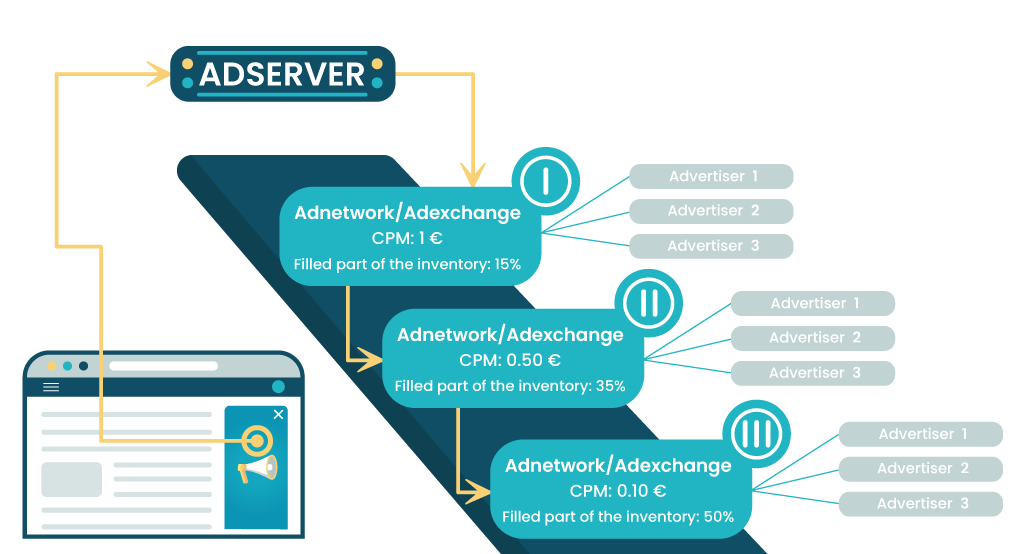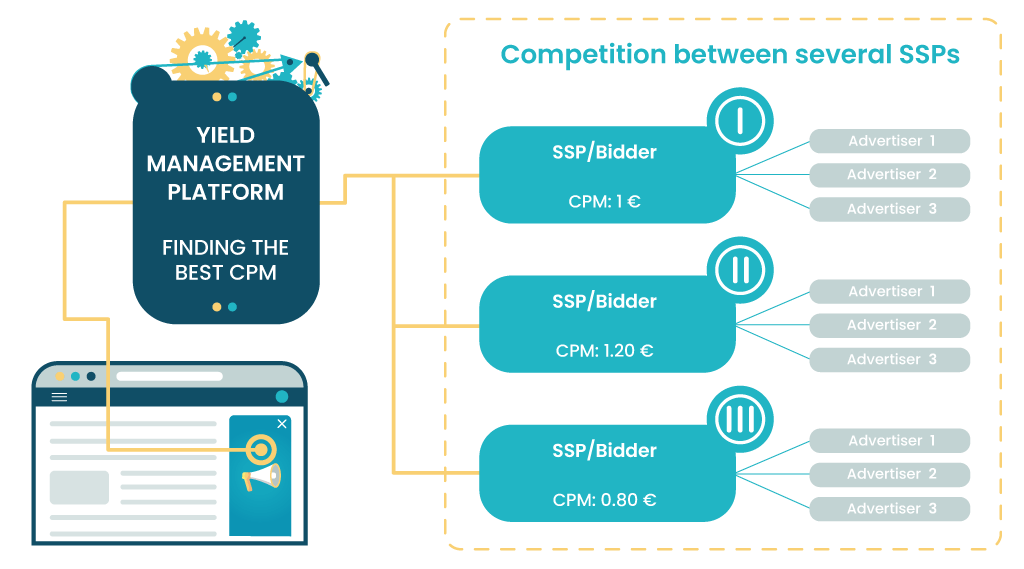Header Bidding vs Waterfall | Differences Explained
Header bidding lets all advertisers bid at once for an ad spot while waterfalling offers the spot to one advertiser at a time in a set order.
Header bidding vs. waterfall is one of the most searched terms in adtech. The waterfall was an industry standard for years until header bidding came and replaced it around 2014.
Waterfall is a sequential method of ad serving, where publishers offer inventory to ad networks in a predetermined order. Header bidding, on the other hand, allows publishers to offer inventory to multiple demand sources simultaneously. All demand sources get an equal opportunity to bid on inventory, and the highest bidder wins the impression.
This article will explain in detail what these two concepts mean for publishers and how to use them!
Programmatic Waterfall Explained
Programmatic waterfall, also known as waterfalling or daisy chaining, is a technique for publishers to sell remnant ad inventory.
Publishers would try to sell their premium ad inventory via direct deals in the early days, which generated more revenue. However, they were often left with ad inventory that wasn’t attractive enough for direct buyers; hence, the programmatic waterfall was developed.
How Does Programmatic Waterfall Work?
In programmatic waterfall, SSPs/ad networks are ranked based on the average historical performance they have produced for the publisher.
This means that SSPs/ad networks with the best record of eCPM, fill rate, latency, etc., will be at the top. The impressions are then passed from one SSP/ad network to another until they’re sold.

Waterfall Model Advantages and Disadvantages
Advantages:
- The waterfall model allows publishers to sell off their remnant ad inventory.
- The waterfalling solution has an easy set-up as it only requires pasting passback tags from one SSP (or ad network) to another.
Disadvantages:
- Publishers receive a low yield because SSPs/ad networks bid on impressions in sequence instead of real-time bidding (RTB), where they bid simultaneously.
- Once the impressions are passed onto the next SSP/ad network (known as “passback”), CPM price floors decrease, preventing high-paying advertisers from bidding more and, ultimately, decreasing publishers’ revenue.
- Since the process is long, it results in high page latency.
- The sequential selling process results in high impression discrepancy, as opposed to where there is a single auction, like in the header bidding.
What is Header Bidding?
Header bidding, also known as pre-bid, is a programmatic technology in which the bid requests are sent to multiple demand partners (e.g., Google AdX, Xandr, Criteo) in real-time bidding (RTB), helping publishers maximize yield for their ad inventory and sell it at the highest price.
Adding multiple premium buyers creates competition, pushing demand partners to pay more for the same ad impressions. Header bidding also allows publishers to offer their premium ad inventory without the risk of underselling it.
Learn all there is to know about header bidding here!
How Does Header Bidding Work?
A header bidding technology sits on top of a header bidding wrapper, which is a JavaScript tag responsible for:
- making ad calls to demand partners;
- evaluating bids;
- communicating with the ad server.
Wrappers essentially help to implement the technology and manage demand partners with ease.
This is how a header bidding wrapper works:
- Firstly, publishers must paste the header bidding code in the page’s header.
- When the user visits the site, the wrapper makes an ad call to all demand partners.
- Demand partners submit their bids. There is usually a time frame (“timeout”) in which bidders must respond to prevent page latency.
- Wrapper sends the bids to the publisher’s ad server (e.g., Google Ad Manager).
- The highest bidder wins the real-time auction, and his ad creative gets displayed on the publisher’s page.

Header Bidding vs Waterfall
| Waterfall | Header Bidding | |
| Technology | Impressions are offered sequentially | Impressions are offered simultaneously (RTB) |
| Revenue | No difference over Google AdSense | 50-80% revenue uplift (up to 300% with Setupad) over Google AdSense |
| Set-Up | Easy | More complex |
| Ad Inventory | Usually remnant inventory | All inventory |
| Latency | High latency | Low latency |
| Fill Rate | Decreases if no one buys the impressions | Increases thanks to increased competition |
| CPM | Impressions are sold at the CPM price floor | Higher CPM because of real-time auction |
| Performance Control | Not possible to evaluate ad performance | Possible to evaluate ad performance using bid-level reporting data |
| Discrepancy | High ad discrepancy | Low ad discrepancy |
| Demand Partners | A limited number | Multiple* |
Do Publishers Still Use Waterfall in 2021?
The waterfall model is not a viable solution to monetize your ad revenue in 2021. However, publishers can still use it to organize their ad inventory or test waterfall before the open auction (RTB) in their direct deals by giving certain advertisers an exclusive “first look” at their ad inventory.
Despite its popularity, header bidding’s biggest challenge is the imperfections of the two types of header bidding wrappers: client-side vs server-side. Client-side header bidding wrapper runs on the user’s browser, which can harm page load speed.
Server-side header bidding auction takes place in the ad server, which solves the page load speed issue. However, the server side lacks cookie matching, which is necessary for targeting, and publishers may sell fewer impressions as a result.
Where Does This Leave Publishers?
Setupad has developed its own hybrid header bidding wrapper, which combines bids from the client side with server-side connections, ensuring that neither revenue nor loading speed is compromised. It is also a light tag-based solution that doesn’t require pasting anything into the source code.
According to a study, most publishers today utilize hybrid header bidding solutions, indicating that this type of setup is slowly becoming an industry standard.
Setupad Self Serve is a perfect solution for publishers with existing GAM accounts and direct SSP connections that provides enterprise-grade management and analytics tools.
For publishers looking for more powerful and advanced technology, Setupad Prebid connects all of their ad space and optimizes direct campaigns with programmatic demand partners (Google AdX, SSPs, Deals).
To implement header bidding, publishers should partner up with a monetization platform. They will benefit from an advanced technology suite, programmatic expertise, and individual approach. If you would like to test our solution for yourself, sign up or contact us at [email protected].



